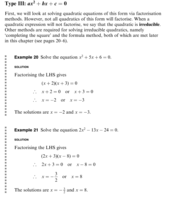CharlieDoggers
New member
- Joined
- Feb 14, 2021
- Messages
- 5
Hey guys
So this is my first time going through quadratic equations, so it's a bit rocky atm.
Right now I'm struggling to understand irreducible quadratic equations. For example 20 (found at the bottom of this post), my understanding is that the bracketed values are as a result of negating the squared symbol from x2 through finding the square root of x2, which results in the formula being x + 5x + 6 (which I hope is the case?). Where I encounter problems is understanding how factoring the LHS will result in (x + 2)(x + 3) = 0. Is this a result of reducing 6 to the potential multiples that will result in 6 other than 1 (if that makes any sense?) or is it related to somehow breaking down the value of 5x into the numbers 2 and 3?
I also included example 21 because of the fact that I have no idea how the values of + 3 and - 8 result when factorised, let alone what has happened to the value of -24 this whole time in the equation's solution.
Once again, any help would be immensely appreciated

So this is my first time going through quadratic equations, so it's a bit rocky atm.
Right now I'm struggling to understand irreducible quadratic equations. For example 20 (found at the bottom of this post), my understanding is that the bracketed values are as a result of negating the squared symbol from x2 through finding the square root of x2, which results in the formula being x + 5x + 6 (which I hope is the case?). Where I encounter problems is understanding how factoring the LHS will result in (x + 2)(x + 3) = 0. Is this a result of reducing 6 to the potential multiples that will result in 6 other than 1 (if that makes any sense?) or is it related to somehow breaking down the value of 5x into the numbers 2 and 3?
I also included example 21 because of the fact that I have no idea how the values of + 3 and - 8 result when factorised, let alone what has happened to the value of -24 this whole time in the equation's solution.
Once again, any help would be immensely appreciated

